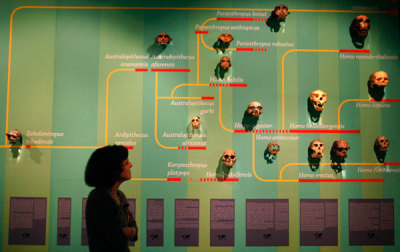Top 3 Reasons Why the Popular Evolution Story Is a Myth

We have Charles Darwin to thank for opening our eyes to the forces of natural selection so useful today in medical research, healthcare, and technology. But Darwin also did us a great disservice, all too blithely extrapolating from observable "bounded" evolution to his Grand Theory of microbe-to-man "unbounded" evolution. In a nutshell, Darwin speculated that, since there is evolution within well-defined species, then all species must surely be the result of evolution. Logical enough, but simply wrong. Darwin's extrapolation is fraught with a host of problems, at least one of which—in three particulars—is fatal to his Grand Theory.
That fatal flaw? The origin of sexual reproduction. Evolution (and evolutionists) simply can't explain it, and Darwin himself never even tried. The way he talked around the edges makes one wonder how Darwin could not have considered the difficulty, especially since he candidly addressed a number of other difficulties with his theory. In his books, Darwin discussed sexual selection, gender divergence, and all sorts of matters pertaining to breeding, but, curiously, not a single word about the origin of sex. Did Darwin simply take sex for granted since the biological world is awash with sex? Was he just too close to the problem to recognize it? Or is it possible that this particular difficulty was too much of a threat to his elegant theory to highlight it for his readers and critics? Whatever the explanation, it's clear that Darwin never seriously dealt with the following three devastating problems with his theory:
1. Natural selection could not have "selected" from genderless asexual replication the DNA information necessary for evolving the very first male and female forms necessary for sexual reproduction. If, as evolution theory teaches, asexual replication was the sole, primitive form of biological reproduction on the planet, in order to move the evolutionary process forward to sexual reproduction it first would have been necessary to evolve separate genders. Male and female forms would have to appear separately, concurrently, and compatibly in order for the first-ever sexual reproduction to occur. Because genderless asexual DNA only enables the production of exact copies, there is no DNA information that possibly could be "selected" to produce never-before-seen gender.
2. Natural selection could not possibly have evolved even the most elementary form of sex bymeiosis—a radically-different form of reproduction from "exact-copy" asexual mitosis. Unlikemitosis, in which an organism simply clones itself by making identical "selfies," male/female meiosisrequires a precise 50% reduction of (compatible) chromosomes, a mind-boggling process of "crossing over," and a breathtaking recombination whereby the offspring is a genetically-different organism from any other that's ever existed. Without having all the right kinds of bells and whistles in place simultaneously in Generation One, the first-ever prototype of male/female meiosis never could have gotten off the ground to move on to Generation Two of sexually-reproducing creatures. No gradual process of natural selection possibly could have evolved this revolutionary form of reproduction.
3. Natural selection could not possibly have provided simultaneous, on-time delivery of the first sexually-compatible pair of any species in order to move to the second generation of that species, nor certainly to any other, "higher" species along the supposed chain of common descent from microbe to man. How do we know we have a distinct species? When it can't reproduce with any other species on the planet. Species are not just different in form and function. Most crucially, they're sexually unique. Despite certain similarities with the mating and reproductive processes of other species, each species is unique in its sexual equipment, its particular method of reproduction, and in its sexual instincts. Since no random, gradual, natural process possibly could have provided the first compatible pair of each of millions of sexually-unique species, no upwardly evolving "evolutionary tree" ever occurred.
Taken together, the first two problems are quietly acknowledged by evolutionists to be the "Queen of evolutionary problems" for which, despite their best efforts, they have no answers. Remarkably, the third (even more obvious) problem is never once addressed by evolutionists. Could that be because, as with Darwin himself, mentioning it would risk destroying an elegant, but fatally-flawed theory?





















